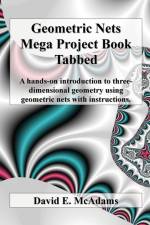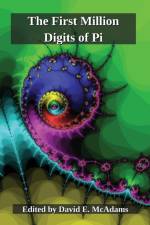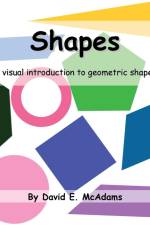av David E. McAdams
465,-
Geometric nets provide many hours of fascinating fun! Each net represents the surface of a unique geometric shape. Some of the shapes were described as much as 2500 years ago.A geometric net is a flat drawing that can be cut and folded into a three dimensional figure. For example, six identical squares can be made into a cube. This is because a cube has six sides, all of which are identical squares. Each of the drawings in this book can be cut and folded into a three dimensional geometric object.This book contains 253 geometric nets, a few of which are:Bielongated Triangular AntiprismConeCubeCuboctahedronCylinderDecagonal AntiprismDecagonal PrismDeltoidal IcositetrahedronDieDisdyakis DodecahedronDodecahedron, RegularElongated Pentagonal BipyramidElongated Pentagonal CupolaElongated Pentagonal PyramidElongated Square BipyramidElongated Square PyramidElongated Triangular AntiprismElongated Triangular BipyramidElongated Triangular CupolaElongated Triangular PyramidFrustum of a Decagon PyramidFrustum of a Quadrilateral PyramidFrustum of a Triangular PyramidGreat DodecahedronGreat Stellated DodecahedronGyroelongated Pentagonal PyramidGyroelongated Square BipyramidGyroelongated Square PrismGyroelongated Square PyramidHeptagonal PyramidHeptahedron 4,4,4,3,3,3,3Heptahedron 5,5,5,4,4,4,3Heptahedron 6,6,4,4,4,3,3Hexagonal PrismHexagonal PyramidHexahedron 4,4,4,4,3,3Hexahedron 5,4,4,3,3,3Hexahedron 5,5,4,4,3,3Icosahedron, RegularIcosidodecahedronOblique Square PyramidOctagonal AntiprismOctahedron, RegularPentagonal AntiprismPentagonal BipyramidPentagonal CupolaPentagonal PrismPentagonal PyramidPentagonal RotundaPentagrammic PrismRectangular PyramidRhombic PrismRhombicuboctahedronRight Pentagonal Star PyramidSmall RhombidodecahedronSmall Stellated DodecahedronSnub CubeSnub DodecahedronSquare AntiprismSquare CupolaSquare PyramidSquare TrapezohedronStellated OctahedronTetrahedron - RegularTetrakis HexahedronTriakis OctahedronTriakis TetrahedronTriangular BipyramidTriangular CupolaTriangular PentahedronTriangular PrismTriangular Pyramid, ObliqueTruncated CubeTruncated CuboctahedronTruncated DodecahedronTruncated IcosahedronTruncated IcosidodecahedronTruncated OctahedronTruncated Square TrapezohedronTruncated Tetrahedron










